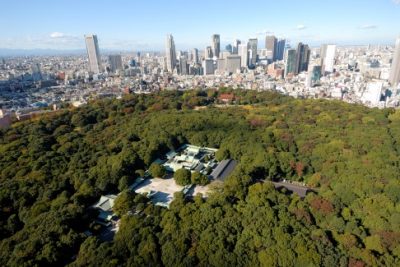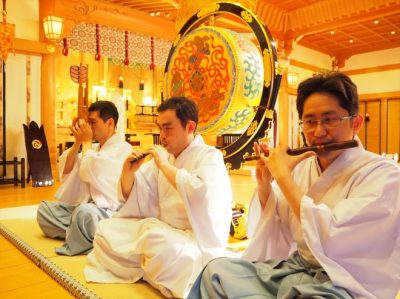SPIRIT OF JAPAN: SHINTO & GAGAKU

- This event has passed.
September 19th, 2018 @ 6:30 pm - 8:00 pm EDT
Cost: FreeDetails » Click here to register »
SPIRIT OF JAPAN: SHINTO & GAGAKU
Japanese Traditional Religion and Music
(Introduction of Shinto and Gagaku performance)
You may think Japan is the country of Buddhism. In fact, there are various Buddhist temples in Kyoto, Nara and everywhere in Japan, and the concept of “Zen” is also familiar. On the other hand, quite many Japanese enjoy Christmas and Halloween, and visit Shinto shrines from time to time.
Shinto is Japanese indigenous religion, which does not have a founder, dogmas and a holy scripture. However, it has been kept as a part of Japanese life (custom) for more than a few thousand years, and for example, millions of people visit Meiji Jingu Shinto shrine in Tokyo for the New Year’s first shrine visit to make prayers.

Shinto priests of this Meiji Jingu will come to The Japan Foundation, Toronto this September, and have an introductory talk about Shinto, the concept of the relation with nature as you can see the forest (picture) surrounding Meiji Jingu, and the connection with the life of Japanese people.
Gagaku –traditional music- has an important role at Shinto ritual ceremonies. Slow and mellow music will lead you to feel Japanese culture rooted into the ancient times of the country. In this event, some music will be performed by three musical instruments (Sho, Hichiriki, Ryuteki). Furthermore, performers (Shinto priests) will give you instructions if you want to challenge/try to play it!
【日本語】
日本は仏教の国というイメージをお持ちの方も多いのではないかと思います。京都や奈良、日本全国には様々な寺院があり、禅という概念にも親しみがあります。一方で、クリスマスやハロウィンを楽しみ、正月には神社に参拝をします。
神道は日本古来の信仰で、創始者や教義・経典を持っていません。しかし、今日もなお日本人の生活の一部として残っており、例えば、東京にある明治神宮は正月の一週間で数百万人の参拝者で賑わいます。この明治神宮からやってきた神職が、神道について、そして広大な森に象徴される神道と自然との関わり、生活との関わりについて解説します。
神道のお祭りには雅楽が欠かせません。ゆったりとした曲調は、遥か遠い昔に根付いている日本の文化を感じさせてくれます。このイベントの中では、三管(笙・篳篥・笛)という小編成で、数曲演奏される予定です。また、参加者の中から希望者には、この雅楽器に挑戦してもらう時間も設けられます。
Bio:
Member: Moriyasu Ito, Atsuki Katayama, Takanaga Tsutsumi
Moriyasu Ito graduated from Kyoto University and earned Bachelor of Law. He entered in the Ministry of Foreign Affairs in 1993 and studied at Trent University in Canada as a trainee, and was posted to Karachi in Pakistan as a cultural attache and vice consul for three years. Back to Tokyo in 1999, he left the ministry in 2003 and entered Meiji Jingu and became a Shinto priest after studying at Kokugakuin University. He is a Chief of the International relation division at Meiji Jingu Intercultural Research Institute. He plays the Sho (Japanese wind instrument assembling panpipes).
Atsuki Katayama graduated from Kokugakuin University in 2003, and entered Meiji Jingu in the same year. His father is serving at Hitomaro Jinja (Shinto shrine), dedicated to the spirit of a poetry Kakinomoto-no Hitomaro (A.D. 660-724), in Yamaguchi prefecture. He became a Shinto priest in 2008 after serving as a trainee for 5 years at Meiji Jingu. Currently he belongs to the Ritual division. He plays Ryuteki (dragon flute).
Takanaga Tsutsumi lives in the life close to Shinto, since his mother was born in the family serving at Kumano-hongu Taisha (Shinto shrine) in Wakayama prefecture. After he studied low at Tokai University, he decided to be a Shinto priest, and entered Kokugakuin University to take one year intensive course for the qualification to be a priest. He has been serving at Meiji Jingu for three years as a trainee, now. He plays the Hichiriki (small double-reed instrument).

